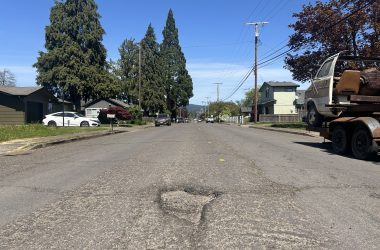 FRANK ARMENDARIZ/THE CHRONICLE A view of the lower Siuslaw River. The river bar was dredged last winter making a crossing less perilous than in recent years. On days that the ocean calms down the bottom fishing has been excellent.
FRANK ARMENDARIZ/THE CHRONICLE A view of the lower Siuslaw River. The river bar was dredged last winter making a crossing less perilous than in recent years. On days that the ocean calms down the bottom fishing has been excellent.
A flyover of Lane County leaves little doubt that fall has come to western Oregon. The rain that fell last week broke the cycle of summer-like days into late September. More rain and cooler temperatures are in this weekend’s weather forecast, too.
Over on the Lane County coast most anglers have turned their attention to chasing the fall chinook salmon that are staged throughout the Siuslaw River estuary, with the largest concentration of chinook upstream of Cushmen. The forecasted rainfall will move some of those salmon further up the estuary to Mapleton and into the lower river near Tide, where they will finally become reachable to bank anglers and pontoon floaters.
I fish a bobber and bait rig through the deeper holes in the river during the fall.
Salmon anglers are a persistent group and the fishing pressure throughout this “one-and-done” season has been surprisingly heavy on the Siuslaw since early September. But with no coho fishing in the bay, the chinook have had to shoulder all of that angler pressure. A few fish are being caught every day but the words “poor” and “fair” would best characterize current conditions – and in general summarizes the entire season.
 Jim Berl and Holly Logan with an Umpqua River smallmouth bass.
Jim Berl and Holly Logan with an Umpqua River smallmouth bass.
The next couple of weeks are make-or-break and will dictate the quality of this year’s fall salmon run. It doesn’t look good.
Folks, it’s not like we haven’t had enough calamity to deal with in 2020. But another downer came last week when the ODFW released fall chinook catch statistics that were pretty disappointing. It gave a fair amount of insight into current conditions and a larger view of the looming problem of diminishing runs. As a point of reference, the Lane County coast and our Siuslaw River is in about the middle of the Cape Falcon to Humbug Mountain salmon management zone, where recent ODFW statistics revealed a range within the zone of “very poor to good” chinook fishing this season.
Overall, 4,394 chinook were landed from an estimated 44,843 angler trips through Sept. 20, with a catch rate at a miserable 0.14 chinook per angler. The best catch rates in the zone were on the northern Oregon coast, out of Garibaldi and among the Pacific City fleets.
A little closer to the southern Willamette Valley is Depoe Bay that also got a “good” rating. But even in the ports rated as “good” a lot of days of fishing did not yield a “whole salmon” per every angler.
The ocean chinook season continues through Oct. 31, the non-selective coho season closed at the end of September. The ocean wasn’t friendly last week and the reports are thin. But on days that the sea lays down the bottom fishing has been very good.
The bass fishing in the dune lakes and in the nearby Umpqua River was excellent again this season. Arguably these are some of the most productive bodies of water in our state. The bass are still fairly active but that will likely wrap up as the next series of weather fronts usher in the fall weather.
But what a wonderful bass season it has been. The fish will become active again in the spring. Bass fishing generally returns in early April.
In the southern Willamette Valley the damage caused by the Holiday Farm fire will be continually revealed for some time. The human tragedy is immense and so is the damage to the environment. For long stretches between Vida and Rainbow the fire burned the banks of the McKenzie River right down to the water. Large portions of the immediate watershed also burned, leaving 180,000 acres of ash, burnt brush and thousands of burnt and downed trees. With winter rains, a lot of debris will likely be washed into the river and the effects are yet to be seen downstream of the fire. But from a biological perspective it should be an interesting process to watch as the river heals.
Not all the news about the McKenzie is bad. I spoke with Jeff Ziller, ODFW’s managing bioligist in the southern Willamette district.
Widely reported was the story of the Holiday Farm Fire bearing down on the Leaburg Hatchery and about all the fish that were released into the river when the hatchery water supply was cut off by the lowering of the dam roll gates. That was important to allow fire debris to pass through the dam. But in the process, the water supply was cut off to the hatchery, prompting an emergency fish release.
“The fish would have surely died in the hatchery without a fresh water supply,” Ziller said. Sadly a lot of those fish were only fingerlings and their chances of survival in the wild are incredibly low. But in the near and long term the negative impacts on future hatchery fish releases will be relatively minor. The hit was mostly limited to the steelhead that were scheduled to be released next spring (2021) as smolts and would have returned to the McKenzie in 2023. Those represented a large portion of the emergency release, along with a lot of hatchery trout. Trout production has also been halted at the Leaburg hatchery and should resume after the new year.
In most cases early season trout plants have in recent years come from Desert Springs Trout Farm. So trout scheduled for release beginning in late January will be at historic levels. Ziller was also confident that trout raised at Leaburg Hatchery specifically for release into the McKenzie would be ready to distribute into the river by next May.
The number of salmon required to produce next season’s release quota were collected before the fire. Those fish were moved to the Santiam Hatchery. Eugene Water & Electric Board raised the water level enough at Leaburg dam last week that water returned to the fish ladder and more salmon were collected to spawn at the Santiam Hatchery for release into other parts of the Willamette drainage also next spring.
Also good news, the recently rehabilitated South Fork McKenzie and lower Deer Creek salmon spawning habitats were spared from the raging flames. And again this year a remarkable number of wild McKenzie River spring chinook reached these two salmon spawning preserves. Downstream from Blue River is the Finn Reach of the McKenzie Trust. Within a few days of the fire, spawning salmon were seen on the beds of the side channels of the main McKenzie that flow through Trust’s holdings.
It’s been hundreds of years since the McKenzie watershed burned so extensively. But watersheds are resilient. We might see sediment and debris the next few years but the river survived and people will rebuild. The larger issue we face is climate change which most Americans agree is a looming danger to humanity and most everything else living on Earth.
Email: [email protected]








